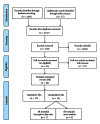Overview of systematic reviews: yoga as a therapeutic intervention for adults with acute and chronic health conditions
- PMID: 23762174
- PMCID: PMC3670548
- DOI: 10.1155/2013/945895
Overview of systematic reviews: yoga as a therapeutic intervention for adults with acute and chronic health conditions
Abstract
Objectives. Overview the quality, direction, and characteristics of yoga interventions for treatment of acute and chronic health conditions in adult populations. Methods. We searched for systematic reviews in 10 online databases, bibliographic references, and hand-searches in yoga-related journals. Included reviews satisfy Oxman criteria and specify yoga as a primary intervention in one or more randomized controlled trials for treatment in adults. The AMSTAR tool and GRADE approach evaluated the methodological quality of reviews and quality of evidence. Results. We identified 2202 titles, of which 41 full-text articles were assessed for eligibility and 26 systematic reviews satisfied inclusion criteria. Thirteen systematic reviews include quantitative data and six papers include meta-analysis. The quality of evidence is generally low. Sixteen different types of health conditions are included. Eleven reviews show tendency towards positive effects of yoga intervention, 15 reviews report unclear results, and no, reviews report adverse effects of yoga. Yoga appears most effective for reducing symptoms in anxiety, depression, and pain. Conclusion. Although the quality of systematic reviews is high, the quality of supporting evidence is low. Significant heterogeneity and variability in reporting interventions by type of yoga, settings, and population characteristics limit the generalizability of results.
Figures
References
-
- Dangerfield A. Yoga wars. BBC News Magazine, 2009, http://news.bbc.co.uk/1/hi/7844691.stm.
-
- Taylor M. What is yoga therapy? An IAYT definition. Yoga Therapy in Practice, 2012, http://www.iayt.org/site_Vx2/publications/articles/IAYT%20Yoga%20therapy....
-
- Macy D. Yoga Journal Releases 2008 “Yoga in America” market study. Yoga Journal Magazine, 2008, http://www.yogajournal.com/advertise/press_releases/10.
-
- National Health Service. NHS: your health, your choices. A Guide to Yoga, 2012, http://www.nhs.uk/livewell/fitness/pages/yoga.aspx.
LinkOut - more resources
Full Text Sources
Other Literature Sources
Medical







